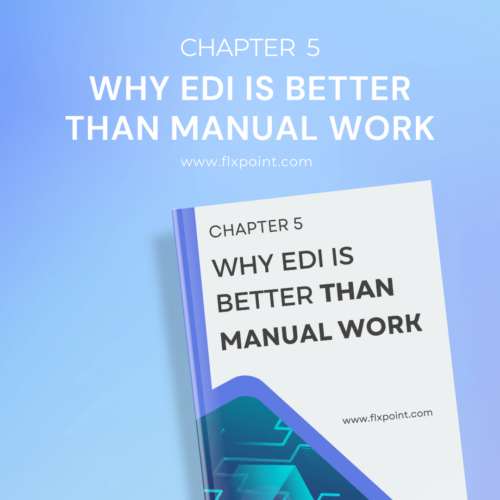Chapter 3 Everyday Uses of EDI in Ecommerce
Uncover the daily applications of EDI in your ecommerce journey. From order processing to inventory management, see EDI in action.

Introduction to EDI’s Practical Applications
Electronic Data Interchange (EDI) streamlines important business processes such as order processing, inventory management, shipping tracking, and invoicing. By automating these tasks, EDI minimizes manual intervention, leading to increased efficiency and reduced errors. This automation optimizes operational workflows, ensuring faster and more accurate task completion. EDI seamlessly integrates with ecommerce platforms and supplier systems, enabling real-time data exchange and fostering strong supply chain collaboration. With EDI, businesses experience numerous benefits, including enhanced productivity, improved communication, and more effective management of business transactions.
Placing Orders Automatically
EDI (Electronic Data Interchange) revolutionizes the way ecommerce businesses place orders by streamlining communication between buyers and suppliers. Traditional methods like emails or phone calls are time-consuming and prone to errors. With EDI, businesses can send purchase orders instantly, ensuring speed and accuracy. This automation enhances operational efficiency and reduces costs, making it a game-changer for ecommerce, especially in dropshipping.
How EDI Enables Seamless Order Placement
- EDI automates the creation and transmission of purchase orders from ecommerce platforms to suppliers.
- It eliminates the need for manual intervention, reducing errors and saving time.
- Orders are sent in a standardized format, ensuring compatibility and understanding across systems.
Examples of Sending Purchase Orders to Suppliers Instantly
- A dropshipper’s ecommerce store receives an order. Through EDI, a purchase order is automatically generated and sent to the supplier within seconds.
- Suppliers receive the order details, such as product specifications, quantities, and delivery addresses, in a structured format, enabling immediate processing.
- This real-time communication speeds up fulfillment, enhancing the customer experience.
Avoiding Manual Errors and Ensuring Accuracy in Ordering
- Manual data entry increases the risk of errors, such as incorrect product quantities or shipping details.
- EDI ensures data accuracy by automating the transfer of information directly from the ecommerce store to the supplier.
- It reduces misunderstandings or delays caused by human errors in interpreting order details.
Benefits of Automated Orders for Dropshipping Businesses
- Speed – Automation ensures orders are placed immediately after a customer purchases, reducing processing times.
- Accuracy – With structured data formats, errors are minimized, leading to smoother operations.
- Scalability – Dropshipping businesses can handle a high volume of orders without the need for additional resources.
- Cost Efficiency – Automation lowers administrative costs by reducing labor-intensive tasks.
- Customer Satisfaction – Faster order placement translates to quicker delivery, which improves the shopping experience.
Managing Inventory in Real Time
Efficient inventory management is essential for ecommerce success. EDI simplifies this process by enabling real-time stock tracking and automating updates across systems. It ensures accurate inventory data, reduces errors, and prevents costly disruptions. Below is a detailed explanation of how EDI improves inventory management for ecommerce businesses.
Real-Time Stock Tracking with EDI
- EDI allows seamless communication between ecommerce platforms, suppliers, and warehouses.
- Real-time stock tracking ensures inventory data is always up-to-date.
- When a product is sold, EDI immediately adjusts the inventory count across all integrated systems.
- This eliminates manual updates, reduces errors, and saves time.
- Accurate stock levels allow businesses to respond quickly to demand and avoid customer dissatisfaction caused by stock inconsistencies.
Preventing Stockouts and Overstocking Through Automated Updates
- Stockouts can result in lost sales while overstocking ties up capital and storage space.
- EDI automation helps balance inventory by providing real-time data on stock levels and reorder points.
- Automated updates trigger timely restocking when inventory falls below a specific threshold.
- Overstocking is avoided as businesses can monitor trends and maintain only the necessary stock.
- The result is improved cash flow, better warehouse management, and enhanced operational efficiency.
How EDI Helps Dropshippers Align Supplier Inventory with Storefronts
- Dropshippers rely on suppliers to fulfill orders, making inventory alignment crucial.
- EDI connects dropshipping businesses with their suppliers, ensuring accurate inventory synchronization.
- Supplier inventory data is transmitted to storefronts in real time, allowing customers to see only available products.
- This prevents selling items that are out of stock at the supplier’s end.
- Dropshippers benefit from reduced manual work and improved customer satisfaction, as buyers receive accurate delivery timelines.
Key Takeaways
- EDI simplifies inventory management by automating stock tracking and updates.
- It prevents stockouts and overstocking, ensuring smooth operations and cost savings.
- For dropshippers, EDI bridges the gap between supplier inventory and storefronts, enabling a seamless customer experience.
By adopting EDI, businesses can enhance efficiency, reduce errors, and build stronger supplier relationships. This demonstrates the clear benefits of using EDI in ecommerce.
Shipping Updates Made Simple
Efficient shipping is vital for ecommerce businesses. EDI simplifies the process by automating the exchange of shipping data between suppliers, logistics partners, and retailers. This automation ensures accurate and timely updates, helping businesses meet customer expectations and improve satisfaction. Below is a detailed explanation of how EDI enhances shipping processes:
Automating the Exchange of Shipping Data
- EDI automates the flow of shipping details, such as tracking numbers, delivery schedules, and shipment confirmations.
- Suppliers and logistics partners can instantly share shipping data with retailers.
- This eliminates the need for manual data entry, reducing errors and saving time.
Tracking Shipments and Notifying Customers in Real Time
- EDI enables the real-time tracking of shipments by integrating it with logistics systems.
- Customers receive timely notifications, including updates on shipment status, estimated delivery times, and potential delays.
- These updates improve transparency and enhance trust between businesses and their customers.
EDI’s Role in Reducing Shipping Delays and Improving Customer Experience
- Automated shipping updates ensure that every party in the supply chain is informed and aligned.
- With EDI, businesses can quickly address issues like incorrect addresses or delayed shipments.
- Faster communication minimizes disruptions and ensures customers receive their orders on time.
- A seamless shipping experience boosts customer loyalty and reduces complaints.
Examples of Shipping Notifications Sent via EDI
- Advance Shipment Notifications (ASN) – EDI sends detailed information about what’s in the shipment, when it’s shipped, and when it will arrive.
- Status Updates – Notifications on key stages like “In Transit,” “Out for Delivery,” and “Delivered.”
- Delivery Confirmations – Alerts to confirm successful deliveries, ensuring closure in the shipping process.
Error-Free Invoices and Payments
Efficient invoicing and payment processes are critical for smooth ecommerce operations. With EDI (Electronic Data Interchange), businesses can eliminate manual intervention, streamline their financial workflows, and minimize errors. This technology ensures invoices and payments are processed quickly, accurately, and securely, fostering better relationships with suppliers and customers.
Simplifying Invoicing and Payment Processes with EDI
EDI automates the generation and exchange of invoices between ecommerce businesses, suppliers, and buyers. Traditional methods like manual data entry or email-based invoices are prone to mistakes and delays. With EDI, businesses can exchange invoice data in a standardized format, ensuring seamless communication. This process also reduces administrative overhead, allowing staff to focus on higher-value tasks.
Ensuring Accuracy and Speed in Financial Transactions
Accuracy is a significant advantage of using EDI in financial workflows. Since invoice details like amounts, tax calculations, and payment terms are electronically validated, the risk of errors is drastically reduced. Additionally, EDI accelerates payment processing by eliminating time-consuming manual approvals. Suppliers receive payments faster, and businesses maintain better cash flow, making EDI a key driver of financial efficiency.
How EDI Reduces Disputes Caused by Manual Errors
Manual invoicing often leads to discrepancies, such as incorrect billing amounts or mismatched purchase orders. These errors result in disputes, payment delays, and strained supplier relationships. EDI eliminates such issues by automatically matching invoices with purchase orders and shipping documents. The system flags inconsistencies immediately, allowing for quick resolution and preventing escalation.
Key Benefits of EDI for Invoices and Payments
- Error Reduction – Eliminates manual data entry, ensuring accurate invoices.
- Faster Transactions – Speeds up invoice approvals and payment cycles.
- Cost Savings – Reduces administrative tasks and associated costs.
- Improved Relationships – Enhances trust and reliability between suppliers and businesses.
The Advantages of Using EDI in Everyday Operations
EDI (Electronic Data Interchange) offers significant advantages for ecommerce businesses by streamlining daily processes. It automates repetitive tasks, reduces costs, strengthens relationships with stakeholders, and supports scalability. These benefits help businesses operate more efficiently and stay competitive. Below are the key ways EDI transforms everyday operations:
Time Saved by Automating Repetitive Tasks
- EDI eliminates manual data entry by automating processes like order placement, inventory updates, and invoicing.
- Businesses can focus on strategic tasks instead of managing routine paperwork.
- Faster communication between systems ensures suppliers and customers receive timely updates.
Cost Efficiency Gained Through Error Reduction and Faster Processes
- Automation reduces costly errors caused by manual input, such as incorrect orders or mismatched invoices.
- Faster processing of transactions, including orders and payments, leads to lower operational costs.
- Minimizing human intervention decreases labor expenses and enhances accuracy.
Enhanced Customer and Supplier Relationships
- Real-time updates on orders, inventory, and shipping build trust with customers and suppliers.
- Accurate and timely communication improves overall satisfaction and reduces disputes.
- Strengthened relationships foster loyalty and long-term partnerships.
How EDI Solutions Scale with Business Growth
- EDI systems easily adapt to increased transaction volumes as businesses expand.
- They integrate seamlessly with new ecommerce platforms, suppliers, and marketplaces.
- Scalable solutions ensure businesses can handle larger inventories and more complex operations without disruption.
Benefits of Using EDI for Long-Term Success
EDI (Electronic Data Interchange) offers more than just short-term improvements in efficiency; it positions ecommerce businesses for sustained success in an ever-evolving market. Here’s how EDI delivers long-term benefits that drive growth and adaptability:
Competitive Edge in a Fast-Paced Ecommerce Market
- Ecommerce is highly competitive, and businesses must operate quickly to stay ahead.
- EDI automates tasks like order processing and inventory updates, saving valuable time.
- By reducing manual work, businesses can focus on strategy, marketing, and customer engagement.
- Faster operations lead to improved customer satisfaction and repeat business.
- Businesses that use EDI often outperform competitors relying on outdated processes.
Improved Operational Transparency and Control
- EDI centralizes data exchange, making it easier to track transactions in real time.
- Businesses gain clear visibility into orders, inventory, shipping, and payments.
- Transparency reduces errors and ensures every stakeholder is on the same page.
- EDI systems also provide audit trails, helping businesses maintain accountability.
- With accurate and up-to-date information, businesses can make informed decisions quickly.
EDI’s Adaptability to Evolving Industry Needs
- Ecommerce trends and consumer demands change rapidly, and EDI evolves to meet these needs.
- Modern EDI solutions integrate with popular platforms and systems, offering flexibility.
- As businesses expand or shift their models, EDI scales effortlessly to support new workflows.
- For example, EDI adapts to manage multi-channel operations or integrate with emerging technologies.
- Businesses using EDI remain agile and ready to respond to market shifts.
Why Ecommerce Businesses Should Prioritize EDI Implementation
- The long-term savings in time, money, and resources far outweigh the initial setup costs.
- EDI reduces manual errors, preventing costly mistakes in orders, inventory, or payments.
- It helps businesses meet compliance requirements and build trust with partners.
- Prioritizing EDI positions businesses as professional and reliable in the eyes of suppliers and customers.
- Adopting EDI ensures a foundation for future scalability and operational efficiency.
Conclusion
EDI has transformed how ecommerce businesses operate daily. By automating key processes such as order placement, inventory tracking, shipping notifications, and invoicing, EDI eradicates the errors and delays inherent in manual data entry. This not only saves valuable time but also ensures unparalleled accuracy, allowing businesses to function seamlessly and scale effortlessly. The benefits of EDI extend beyond efficiency. It strengthens supplier relationships and enhances customer satisfaction by streamlining operational workflows.
Furthermore, EDI-powered automation fuels long-term growth, enabling businesses to remain competitive in the dynamic ecommerce landscape. Embracing EDI solutions is no longer a luxury; it’s a necessity for companies seeking sustainable success. By implementing EDI, businesses can significantly reduce costs, boost productivity, and future-proof their operations in an ever-changing market. Now is the opportune moment to investigate EDI’s potential and integrate it into your business strategy to achieve lasting profitability.
Guide Chapters
- Chapter 1: What is EDI?
- Chapter 2: How EDI Helps Ecommerce Businesses
- Chapter 3: Everyday Uses of EDI in Ecommerce
- Chapter 4: How to Start Using EDI
- Chapter 5: Why EDI is Better Than Manual Work
- Chapter 6: EDI vs. APIs: What's the Difference?
- Chapter 7: The Future of EDI in Ecommerce
- Chapter 8: Your First Steps with EDI
- Chapter 9: EDI is the Future of Ecommerce
- Chapter 10: Quick Glossary of EDI terms
- Chapter 11: Checklist to Prepare for EDI Setup
All Chapters in This Guide

Start with the essentials. This chapter breaks down what EDI is, how it works, and why it’s a critical tool for modern ecommerce businesses. We simplify the technical jargon so you can clearly understand how EDI automates the exchange of business documents with your suppliers, warehouses, and trading partners.

Explore the powerful benefits EDI brings to your ecommerce operations. From faster communication and fewer errors to cost savings and improved accuracy, this chapter shows how EDI makes your business leaner, smarter, and more competitive.

See how EDI shows up in real day-to-day workflows. This chapter highlights common applications like order placement, shipping confirmations, inventory updates, and invoicing—so you can understand the practical ways EDI supports smooth operations.

Ready to get started? This chapter walks you through the process of adopting EDI, including evaluating your current tech stack, selecting the right partners, and integrating EDI into your existing systems. No technical background required—we make it approachable.

If you're still relying on spreadsheets, emails, or manual uploads to exchange data, this chapter is a game-changer. Learn how EDI eliminates human error, speeds up workflows, and allows your business to scale without adding more headcount.

Wondering when to use EDI or APIs? We break down the differences between these two powerful tools, when each makes the most sense, and how they can work together in a well-rounded ecommerce tech stack.

EDI is evolving rapidly. In this chapter, we explore upcoming innovations—like machine learning, tighter integrations with fulfillment partners, and greater automation. Discover how to stay ahead of the curve and be ready for what’s next.

It’s time to take action. This chapter provides a hands-on guide to assessing your business readiness, aligning with trading partners, and identifying the tools you need to implement EDI smoothly and successfully.

This isn’t just a short-term solution—it’s a long-term strategy. Learn why businesses adopting EDI today are better positioned to grow, adapt to change, and lead in a digitally connected ecommerce world.

EDI doesn’t have to be intimidating. We’ve created a glossary of key terms and acronyms to make the language of EDI more accessible, so you can communicate confidently with partners and providers.

Make sure you’re truly ready. This checklist walks through everything you’ll need to set up EDI the right way—from choosing the right platform to aligning your workflows and evaluating technical requirements. Consider this your pre-launch playbook.
Kenneth Cole's Smart Savings With Shopify EDI Connections
"They had never used Flxpoint before. But working with [the Flxpoint] team, they learned it and we're about to onboard our newest footwear partner, and you know that's big business for us.”
Mitul PatelKenneth Cole


How Flxpoint Helped Rifle Supply Automate & Grow
“I went line by line… whatever the inventory number was and cost value was, I calculated it and was blown away by how much that was worth— $300 million worth of product that I added to our web store.”
Chris MekdaraRifle Supply


The Ecommerce Automation Behind Screen Skinz
"Automation is the key to maximizing your volume. [Flxpoint] comes right into our flow — everything's automated. We want it to be quick and efficient. So that's what we love about Flxpoint."
Shaun Brown & Clay CanningScreenSkinz


How Inhaven Transformed Vendor Management with Flxpoint
"We ended up switching to Flxpoint, and it has been a much smoother process. Where it took us six months to get onboarded with the other company, we were up and running in a week or two with Flxpoint."
Ashley ChingInhaven


How Black Patch Performance Scaled Smarter with Flxpoint
"The only way to actually scale was to go through Flxpoint… You can’t even come close to hiring someone to do what Flxpoint does for the price."
Jonathan WilliamsBlack Patch Performance


